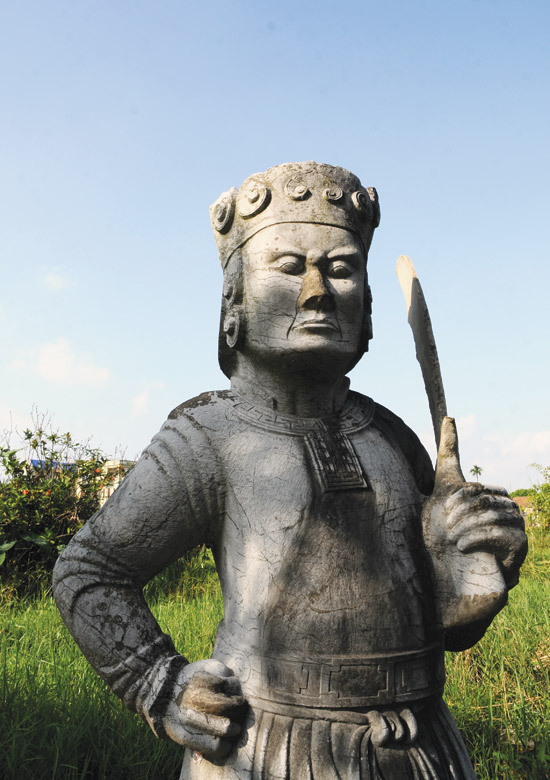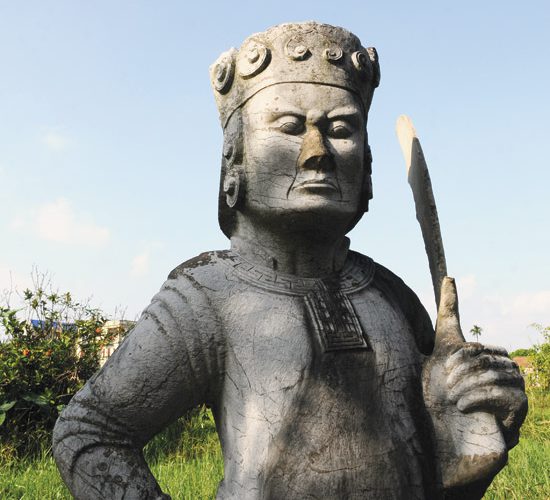(No.11, Vol.4,Dec 2014 Vietnam Heritage Magazine)

A statue of the guard outside.
Just 20 km South of Hanoi, Van Tao Commune is a peaceful land, with many pure Vietnamese cultural features. People here are mostly farmers, attached to their paddy fields. Recently, I learned the bonsai has become their new source of income.
The rollercoaster development in the city seems not to affect life here. Around the new industrial zones, there are bazaars where one can buy plants, chickens and pigs. In the villages, people still use well water. Laterite walls and tile roofs slowly weather, waiting for time to cover them with a coat of moss.
Perhaps that’s why the soft solemnity pertaining to northern culture still glows around the temples and pagodas in this area. Who would fancy that a grand relic lay just a few yards beneath this unassuming ground?
Tradition says that Admiral Duke Do Ba Pham of Dai Giang was a useful figure under Lord Trinh Cuong. When Prince Trinh Giang succeeded to the throne, Pham fell out of grace. He started preparing for a world without him. He ordered stones from Dong Trieu, Quang Ninh Province to be placed on waterways to Van Tao, where he saw a good land formation. He hired master stone masons to carve the stones and build his tomb on joints, without bonding materials.
The whole area is divided into three parts; the gate, the pre-death tomb, and the grave. Architecturally, the tomb is the most notable part. On both sides of the path leading into the tomb, there is an incense table made of monolithic stones, intricately carved. On the tablets is written ‘Dragon and horse play ball’ and ‘Lions kow-tow’, together with reliefs of lotuses, clouds and fire and even an ink-slab and brushes.
Another notable detail is the stone throne, similar to those in the hind part of the village communal houses next to the Land Lord’s votive tablet. Remarkably, the stone carvings on this throne are no less delicate and meticulous than the wooden ones.
The last part is an obelisk that houses the gravestone, and the grave of the Admiral Duke Do Ba Pham of Dai Giang. The obelisk design is quite unique, because the stone roof and the four supporting pillars are connected only by joints, but the structure is very solid. The gravestone tells of the three generations of merits of the Duke, but carries no date of death.
The grave house right behind the obelisk has the typical turtle shell shape, with a spiky top and four roofs. There is a rumor that there used to be buildings around the grave house and the grave has a mechanical trap that makes it collapse if intruded upon.
One can talk for days about the architecture of Admiral Do Ba Pham’s tomb, because it is a landmark masterpiece which remains almost intact. But the most impressive are the statues, especially the totem statues, which are purely Vietnamese. The pure essence of the Vietnamese shows in the peacefulness, gentleness and realness of the statues and the animals.
Outside the gate, a pair of stone dogs in tintinnabula used to stand guard. One of them is missing, and the other is seriously damaged. But dogs are the house keepers and the remaining dog’s bearing shows it. Right behind the dogs stand two sturdy and serious-looking guards. The guard statues are made very realistically, from body size to facial features.
The most impressive is the pair of real-size, authentically detailed stone elephants. They must have been made by master carvers with great knowledge. They are twins, with deep-set, expressive eyes. Elephants are usually encountered at temples and pagodas, but this pair is one of a kind because they are too beautiful, too real.
Behind the crouching elephants is a pair of full-size horses. They are real in every detail, without any flourishes or stylization. We can even learn from them how people used to harness horses at the time.

A couple of stone dogs and their puppy crouching in
front of a stone throne

A crouching stone elephant

A pair of stone lions
Photos: Nguyen Tat Dinh
Then, another pair of stone dogs. These don’t sit like the guard dogs at the gate, but crouch in front of the second incense table before an obelisk. The special thing about these dogs is that they were made without any sophisticated detail. They seem to be a couple, male and female, and there is a puppy sitting next to the female. It’s a happy dog family. And of course, these dogs are cute and tranquil, not fierce at all.
The only unreal things present in the tomb area are the lions. Interestingly, although made 300 years ago, this stone lion pair is still very new. They show power and authority, but at the same time seem to be friendly and easy to approach.
Ms Pham Thi Cuong, whose family has lived at the tomb gate for 4 generations, said that the whole village knew nothing about the tomb because it was buried too long ago. Previous generations had to worry about famine and social turmoil. The great flood of 1914 broke the dykes and smashed away everything on its way. Only the strongest buildings on the highest spots survived. People had to evacuate en masse. When the flood water receded, everything, including Duke Van’s tomb, was buried under the alluvial soil.
As a witness of the excavation of the tomb, Ms Cuong said that it was done in 1984 or 1986. Miraculously, the tomb was almost intact.
Ms Cuong has seen all of the places in her district, and she is sure that such beautiful totem statues can be found nowhere else. A few years after the excavation, life was too hard, so only very few people came to see the tomb. Later, when things got better, many came to contemplate the wonders, and she began to help the curator to take care of the tomb.

